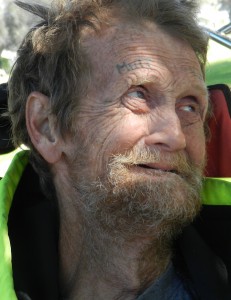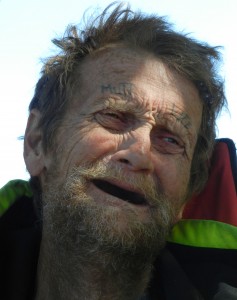
For many people, it’s axiomatic that homelessness is the inevitable result of drug use and addiction, and drug use and addiction themselves are the wages of sin. Oddly, these views of addiction no longer prevail among white middle- and upper-class people whose friends and family members have become victims of a heroin epidemic brought on in large part by over-prescribed pain-killers.
Recently, when Carly Fiorina interrupted a Republican presidential debate to argue we need to spend more money on drug treatment, no one castigated her for coddling drug users. Her story of the loss of a daughter was instead received as a moving example of the power of addiction to destroy lives.
In fact, there’s always been a huge class divide when it comes to how we view addiction. Consider former first lady Betty Ford: When her dependence on alcohol and prescription drugs became public, she received an outpouring of sympathy. Her problems were attributed to the stress of public life and her popularity soared. She went on to establish centers for treating what many experts then viewed as a disease rather than as a moral failure—and that was almost forty years ago.
And at least since the notorious laudanum-fueled poetry of Samuel Taylor Coleridge, celebrities have had what amounts to a free pass for their drug use. Robin Williams, Ray Charles, David Foster Wallace, and any number of other gifted artists have always been able to attribute their drug habits to the special pressures of creativity and public performance, even while members of the working class were inevitably seen as weak and degenerate for the same vices.
During the 80s and 90s it became fashionable to attribute problems with alcohol and drug use to “bad choices.” An emphasis on character and personal responsibility made addiction and abstinence simple matters of willpower and prudence. “Just say no,” became a mantra of the times, making the “choice” whether or not to use drugs as simple as the choice whether or not to brush your teeth.
Redemption was always possible, but happened only when the user “hit bottom” and had a spiritual awakening. So it was that when George W. Bush faced up to his longtime abuse of alcohol, he was able to turn his life completely around. Within a short time, his nearly bankrupt oil business was purchased by Harken Energy, he became part owner of the Texas Rangers baseball team, and then went on to become president of the United States.
Bush’s own emphasis on a Christian “awakening” fits the traditional view of drug use as a spiritual or moral problem, but it’s very much at odds with what modern science has to say about addiction. And his ability to turn his life around had at least as much to do with the safety net provided by his family connections as by his spiritual awakening.
Most others who experience the ravages of alcoholism or drug addiction aren’t as lucky. In Methland, Nick Reding documents the destruction of an entire small town in Iowa when residents turn to methamphetamine after the local economy is rocked by globalization and outsourcing. Sam Quinones’ Dreamland traces the origins of today’s heroin epidemic to overprescribing OxyContin, a painkiller promoted by its makers as non-addictive.

In both cases, drug use was as much a matter of social forces as it was personal choice. When factory jobs left Oelwein, Iowa, its hardworking Midwestern residents found that methamphetamine could provide the energy to work two lower-paying jobs in futile attempts to replace income from lost jobs. And even hyper-conservative talk-show host Rush Limbaugh succumbed to the addictive powers of OxyContin during the heights of its popularity with doctors and prescription drug users. He didn’t descend to the level of cheap heroin use only because he could easily afford the much higher price of the FDA-approved product, even when purchased illegally.
Church-going Midwesterners and affluent conservatives from good families hardly fit stereotypical views of drug users, but there are far more of them than there are homeless drug addicts. Nonetheless, homeless people remain the favored targets of those who see addiction as the ultimate societal sin.
Even efforts to help homeless people by offering them food are often labeled as “enabling” drug use. When they’re not arrested, proselytized, or harassed, homeless drug users are exhorted to seek “rehabilitation” and twelve-step programs, despite the very poor success rates of such standard approaches.
Locally, the cheapest private rehabilitation programs begin at around seventeen-hundred dollars a month and escalate rapidly upwards. Of course, if one is affluent enough, treatment at a prestigious Betty Ford Center can run a thousand dollars a day, with no guarantees of success.
Homeless people lucky enough to gain access to crowded programs funded by government subsidies find that when the thirty, sixty, or ninety day regimen ends, they’re back on the streets with nowhere to go. Local shelters offer places to spend the night, but during the day homeless people are on their own.
Even low end “Clean and Sober” housing can run six-hundred dollars a month, and that’s with a shared room. Depending on management and ownership, residents may or may not be clean and sober and the facility itself is often less desirable than a tent along the river.
Instead of compassion and expensive treatment programs, homeless drug users are subjected to endless rounds of stigma and criminalization. The unremitting pain of broken family ties, ruined health, and public shame is compounded by the knowledge they never have a safe place to stay.
And while it’s easy to blame addiction on addicts, it’s much less easy to justify the persecution of homeless addicts on the basis of a belief in prevention or rehabilitation. Nonetheless, the overwhelming evidence that punishment doesn’t work—either as deterrent or cure—isn’t enough to stop public demands to keep rousting and jailing homeless people, and that may be the most toxic of all drug effects.

Great article Eric.
Thank you Dan. More to come.
Your investigative work, and interesting writing style are really special. I am so glad you have focused on our homeless problem here. Thank you!
Thank you Richard. Your own work has been an remains a daily inspiration. Great video of White Horse!